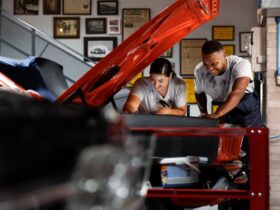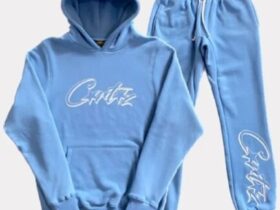Workwear: how important is it really? And perhaps more importantly, what role does workwear play in the brand change? This is a question I get asked a lot in my work as a project manager for large brand change projects. My answer is simple:
Workwear is one of the most important elements in a brand change for two reasons. First, your employees are the ambassadors of your company. This contributes to how your customers perceive your brand and ultimately your company. Second, workwear affects the work experience of your employees. Whether they wear their uniform with pride or reluctance makes a big difference in how they work and how they represent your brand.
What types of workwear are there?
There are different types of workwear. Some are purely functional, designed to help your employees carry out their tasks comfortably or safely. Others are more for aesthetics and are mainly worn to promote the brand:
Promotional clothing for events and campaigns.
Formal attire typically worn by frontline staff (e.g. uniforms for hotel employees).
Work-specific clothing, such as mechanic’s overalls and work trousers, as well as uniforms used in the care and service sector (e.g. jeans, tunics, shirts, sweaters).
Personal protective equipment (PPE) such as helmets, safety vests and shoes, and rain gear.
Why is it important that workwear reflects your brand?
Uniforms are visual brand carriers. They are a crucial element in your offline branding strategy and contribute to brand recognition. Take DHL for example. When you see someone in the iconic yellow and red uniform standing in front of your door, you immediately know who they are, what company they work for and what they are there for.
Workwear also helps employees feel connected to your company and their jobs. And when employees feel connected to the brand they represent, they can better fulfill their role as your brand’s most important ambassadors.
How companies approach workwear rebranding
Companies carry out workwear rebranding projects in different ways depending on what their particular situation dictates. In my experience, there are typically three ways companies introduce new uniforms into their organization, with the first two being the most common:
- Natural exchange cycle
As with most other brands, companies renew their workwear at regular intervals. In this case, the new uniforms are introduced gradually and it is not uncommon for new uniforms to be used alongside the old uniforms. While not ideal, especially from a branding perspective, this solution is the most cost-effective way to rebrand workwear. - “All at once” – exchange
In companies where workwear is an integral part of brand identity, the uniform change is usually more radical. This then often coincides with large-scale brand changes, with the new workwear reflecting the brand’s new visual identity. - Renewal of existing clothing
There are also scenarios where workwear rebranding involves renewing or updating existing workwear, e.g. B. by replacing the logo. While this type of workwear rebranding is less common, it is still a possibility.
In this blog, I would like to focus on the “everything at once” rebranding of workwear. This is the most complex approach, not so much because the process is lengthy and complicated, but because there are many factors to consider.
5 factors to consider when rebranding workwear
The following are the most important factors to consider when rebranding workwear:
- Employee Acceptance
Employees are the ones who are most affected by the reorientation of their workwear. After all, they are the ones who have to wear the uniforms every day. Your workwear not only influences the way you work, but also your employees’ overall sense of belonging within the company. For this reason, they must be taken into account when selecting and developing workwear.
Here are a few steps you need to take to ensure your employees accept and feel comfortable in their new workwear:
Organize fittings so employees are happy with the fit and quality of their new workwear.
Offer workwear options that meet specific employee needs (e.g., custom sizes, religious considerations, etc.).
Assemble an expert group with enough staff members to ensure staff voices are heard.
Communicate the introduction of new workwear with your employees to increase their enthusiasm and acceptance.
2. Workwear Laws and Regulations
Some countries have very specific workwear laws, especially when it comes to taxes and employee safety. Find out about these legal requirements before you make important decisions about redesigning your workwear.
- Standard vs. custom workwear
Workwear can either be bought off the rack or made to order. The difference is mainly in convenience and cost:
Ready-made workwear
Buying workwear off the rack is easier, faster and in some cases cheaper. All you have to do is provide logos and simple design instructions to the supplier. The supplier can then apply these to readily available garments, usually by embroidery or sealing. This eliminates the lengthy process of selecting and testing garments. While this option is undoubtedly convenient, it also has its drawbacks. For one, design choices are limited to what suppliers have in stock, and that can change for a variety of reasons (e.g. production cessation). There aren’t that many color, design, and size options either, so it may not be able to meet everyone’s needs.
Tailored workwear
Tailored workwear is the best way to ensure your workwear meets the exact needs of your company. You can choose to have an agency design the uniform and then find a manufacturer to produce the garments, or go directly to a manufacturer who has an in-house design team. While this can be more expensive than buying them off the rack, ordering the uniforms in bulk can cut costs significantly. In situations where visual identity—rather than speed—is the primary goal for workwear transformation, tailored uniforms are often a better option.
- Responsible choices in clothing manufacturing
In addition to a manufacturer’s production capabilities, it is also important to consider its location as it can affect the production process and costs. Most of the workwear clothing for builders manufacturers are located in Asia, particularly in China, Bangladesh and India. There are also clothing manufacturers in Europe, most of them in Turkey, Italy, Portugal and parts of Eastern Europe. When choosing the region to source your workwear from, there are a few important factors to consider:
Price: In general, clothing production in Asia is significantly cheaper than in Europe (by up to 50%). And while transport costs add to the overall cost of making your uniforms in Asia, they are still significantly lower than the cost of workwear made in Europe.
Time: Manufacturing uniforms in Asia is slower because the development process (i.e., sharing, evaluating, and testing fabrics and patterns) takes longer due to distance. Delivery is also expected to be slower, as shipping from Asia can take anywhere from two to four months, compared to the few days it would have taken to transport the uniforms overland within Europe.
Working conditions: The global fashion industry has long faced issues of inhumane/illegal working conditions as well as sustainability issues. Although these problems are more likely to occur with Asian manufacturers, the European clothing industry is not without its problems. Both inside and outside the fashion industry, numerous initiatives and labeling standards have been created to reassure customers that ecological and ethical labor standards are observed in production. Even if these initiatives offer a certain security, the question of credibility arises. Which of these standards and seals of approval are the most accepted or are the most credible? What do these seals and initiatives cover? To give you a little more clarity, I have one Compiled an overview of some of the most popular initiatives and labeling standards and the specific topics they cover.
Recycling: The introduction of new workwear also raises the question of what to do with old workwear. While a charitable donation is always an option, many companies hesitate because they don’t know where the uniforms will end up. No company wants their old company logos on a child soldier on the eight o’clock news. While some providers will offer to collect and recycle your old uniforms, this often comes at an additional cost and tends to be more symbolic than functional or even financial in value. That’s why it’s important to do your research carefully about your recycling options.
- Measurement, ordering and logistics
Aside from the actual production issues, rebranding workwear brings other challenges including getting the measurements right, ordering, and distributing them consistently:
Measurement: Discrepancies in sizing standards are one of the most common challenges when ordering made-to-measure construction workwear. For one thing, sizing standards can vary from region to region and a plus size garment from one supplier may differ from another. In addition, there are regional differences in physique, which can also affect the fit of clothing. While giving employees the opportunity to try on clothes seems to be the most practical solution, this is not always possible, especially in larger companies. The best solution would be to use standard supplier size charts, conduct online consultations or use virtual avatars.
Ordering: Different providers also have different ordering systems. These systems are typically designed to have employees register their garments and size information in an online tool. When choosing a vendor, be sure to request a demonstration of the ordering system, try it out, and include desired features in the bidding process to ensure efficiency and accuracy. It is also wise to set up a point system for financial support for the purchase of workwear rather than simply allocating a financial budget.
Logistics: As for logistics, getting the uniforms from the supplier to your warehouse is the easy part. What comes after presents a greater logistical challenge. It’s important to create a plan that makes it easier to get the uniforms to the right people, avoiding mistakes and mix-ups. It is also important to have a clear return policy, especially in relation to costs, in the event that employees receive the wrong workwear or poor quality.








Leave a Reply